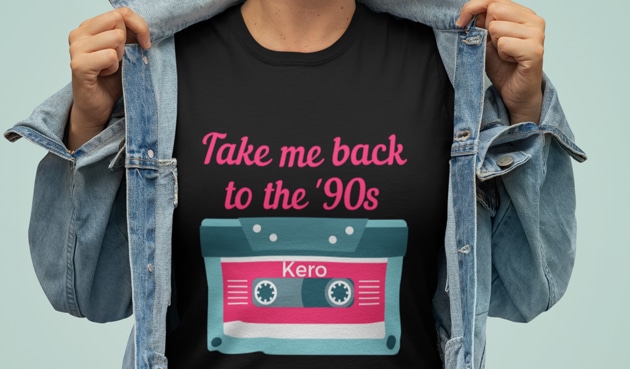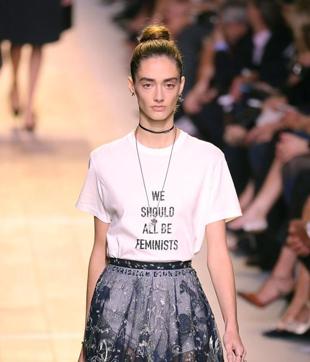Complexi-tee: Why are brands trying to reinvent the T-shirt?
As large brands play it safe, new start-ups are hoping to disrupt casual basics by giving the wardrobe staple some top-quality upgrades.
Why has shopping for a basic tee become as complicated as a Starbucks order? You must pick from options for shape (longline or muscle), material (cotton or a blend?) and finish (combed or ribbed?). Is silk-blend as luxurious as it sounds? And what on earth is supima?

Sonali Shah, founder of Kero, a year-old brand that focuses on high-end women’s T-shirts that feature edgy slogans and graphics, says this category is the golden ticket for casual-wear makers.
“Everyone wants to create a T-shirt that will become the user’s favourite garment. The aim is to offer the comfort of something you’ve worn forever, but a look that survives wash after wash. And more than print quality, it’s the material and fit that delivers,” Shah says.
The quest to make a better T-shirt is as old as the T-shirt itself. The first commercially produced tees weren’t made by a big brand, weren’t outerwear and weren’t even for the public. Thin knit-cotton sleeved vests were issued to US Navy men in 1913 as undershirts so that the uniforms themselves could be re-worn without laundering.
The labour class loved it. The T-shape could be cut quickly from cheap cloth, the stretchy knit was comfortable and didn’t restrict movement. Americans were buying tees in department stores by the 1930s.
But they were still underwear, which is partly why they caused such a stir in the 1951 film A Streetcar Named Desire. Marlon Brando, muscled, scowling and unbelievably sexy, was also all but bursting out of his. James Dean then wore them in the 1955 film Rebel Without A Cause. And there was no turning back.
Tie-dye T-shirts fit in with the ’60s hippies. Graphic designer Milton Glaser turned them into merchandise with the “I <3 NY” logo in 1976. London designer Vivienne Westwood saw them as platforms for subversive slogans and symbols (including swastikas) in the ’80s, even as Bruce Springsteen rolled up his tee sleeves at concerts.
Rappers drowned in oversize synthetic tees in the ’90s. A black Gap tee peeked out of Sharon Stone’s ensemble at the 1996 Oscars. In the last two decades, the T-shirt made an icon of Che Guevara, indicated that ‘This Is What A Feminist Looks Like’ and became an oft-bedazzled luxury fashion staple.
In India, large brands play it safe with mass-appeal designs and classic fits. Smaller brands are hoping to disrupt the casual basics market and create cult favourites. Four-year-old brand March focuses on print-free, logo-less, dense-knit T-shirts for men and women, with lighter, more relaxed range for home wear. Labels like Plair, The Souled Store, Post Fold, Kulture Shop, Black Coccoon and Know Your Origin push the idea that how you feel in it is as important as what it says.
Even fast-fashion brand H&M has been blending cotton with silk, creating an upgraded niche line that looks luminous and feels luxurious.

And because they are produced in the thousands not lakhs, and often print on demand, it’s easier to experiment and have T-shirts capture the zeitgeist. Know You Origin has a black tee with the slogan This T-Shirt Is White – Indian Media, which did well as conspiracy theories mounted over actor Sushant Singh Rajput’s death, on TV news channels. Actor Rhea Chakraborty wore Souled Store’s Let’s Smash Patriarchy tee to a court hearing, prompting the company to relaunch the model on popular public demand.
“The T-shirt’s relationship with India is changing,” says Shah. “Women who would have worn just salwar kameezzes now wear T-shirts.” And pandemic-era India is realising that a comfortable tee, born out of the here and now, is worth the hunt.
High-quality T-shirt will have...
Good materials. Cotton T-shirts are easy to find. The good ones are often 100% organic cotton, with a heaviness or loose weave that fits your preference. Combed cotton looks smoother, ribbed stretches better, ring spun and supima indicate stronger, more durable fibres. Polyester and blends dry faster and are great for sportswear.
A weave perpendicular to the garment. It means the manufacturer didn’t cut diagonally from the fabric to get the most T-shirts from each swatch. It also means the side seams won’t twist across your body after five washes.
Fully finished stitching. Even if it’s a distressed style, the hems will be completed, the folds will have more than one kind of stitch, and it won’t bunch at the underarms.
A brand that explains what they do. “Many manufacturers will copy a description from another brand, or have explanations that look like a bad Tinder bio,” says Sonali Shah of Kero. Check the brand’s website or social media to find out if they really walk the talk.
Catch your daily dose of Fashion, Health, Festivals, Travel, Relationship, Recipe and all the other Latest Lifestyle News on Hindustan Times Website and APPs.




